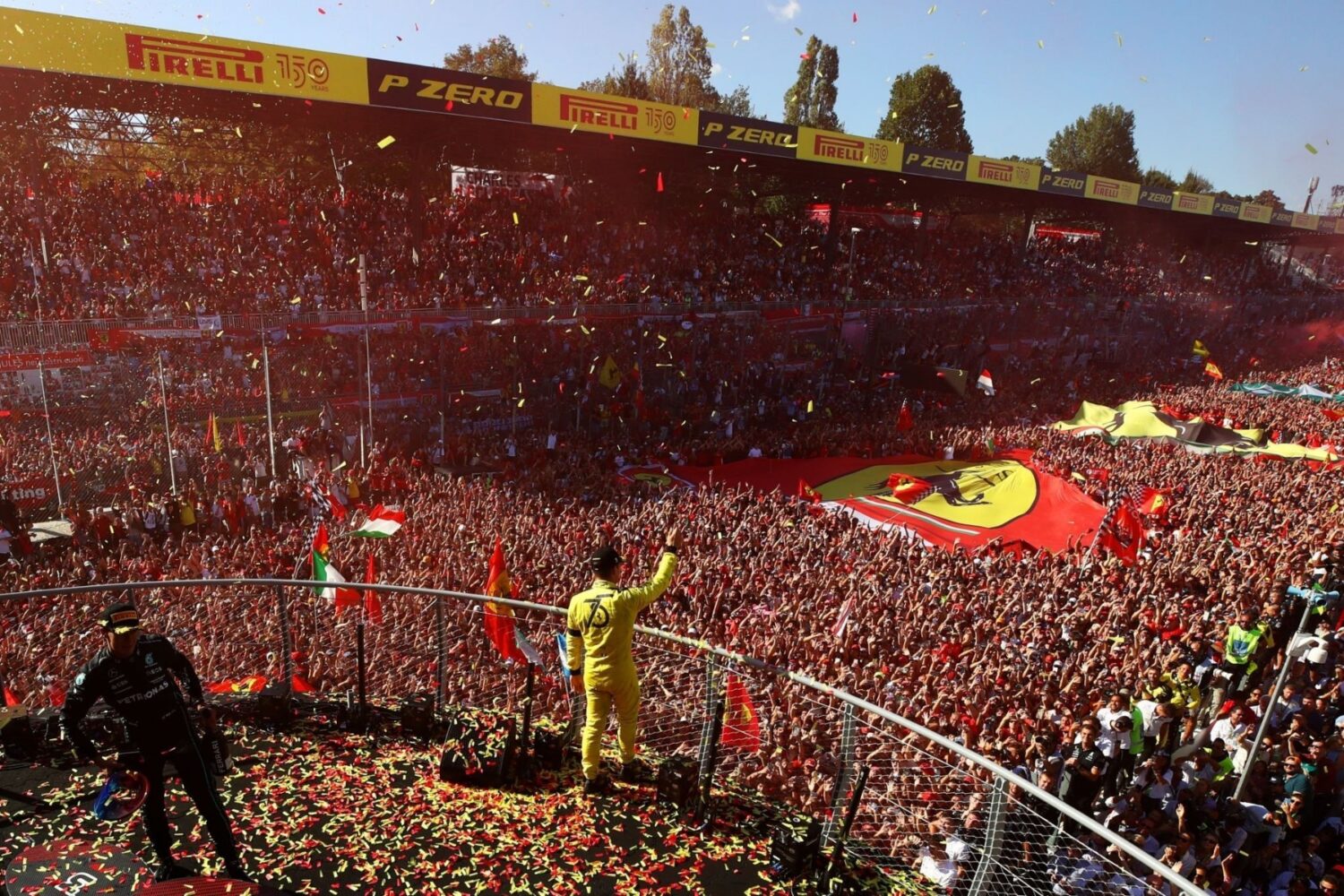Formula 1 News: 2024 Italian GP at Monza Preview (Update)
The FIA extended the Monza main straight DRS activation zone by 103 meters for this year’s Italian GP. As a result, it will be easier to overtake.
August 29, 2024
The 2024 FIA Formula 1 World Championship season will continue with the Italian Grand Prix, at the Autodromo Nazionale Monza this weekend.
–by Mark Cipolloni–
The Autodromo Nazionale Monza is the oldest permanent race facility in mainland Europe, having opened its doors in 1922, and its tarmac has been graced by the greats throughout the history of Formula 1. Monza, located to the north of Milan, has hosted more grands prix – 73 – than any other venue on the Formula 1 calendar, having been absent only once, in 1980. Monza’s history, its location within the protected woodland royal park, and the presence of the fanatical Tifosi creates a near-mystical aura as Formula 1 prepares to close the chapter on its European campaign.
Throughout its history Monza has been dubbed the Temple of Speed and the basic layout – minus the fearsome banked oval – has remained largely unchanged throughout its 102-year existence. Teams run low downforce packages, with skinny wings, in order to maximize straight-line speed around Monza’s 5.8km layout.
The fastest ever lap in Formula 1 was set at Monza, in 2020, when Lewis Hamilton recorded an average lap speed of 264.363km/h on his way to pole position. However, while top speed is highly desirable, drivers also require confidence to tackle the crucial complexes, such as the Ascari chicane, Parabolica and Lesmo curves. A strong car under braking for the Rettifilo and Roggia chicanes, and traction out of those slow-speed complexes, is also critical in delivering the optimum lap time.
The high-speed venue, located in the verdant parklands north of Milan, is this year celebrating its centenary. Monza was part of the inaugural World Championship season in 1950 and has only once been omitted from the calendar, when it underwent renovation works in 1980. The circuit has evolved across its 100-year existence, but the relics of the past remain, such as the iconic banking, which weaves its way through the forest as a nod to Monza’s history.
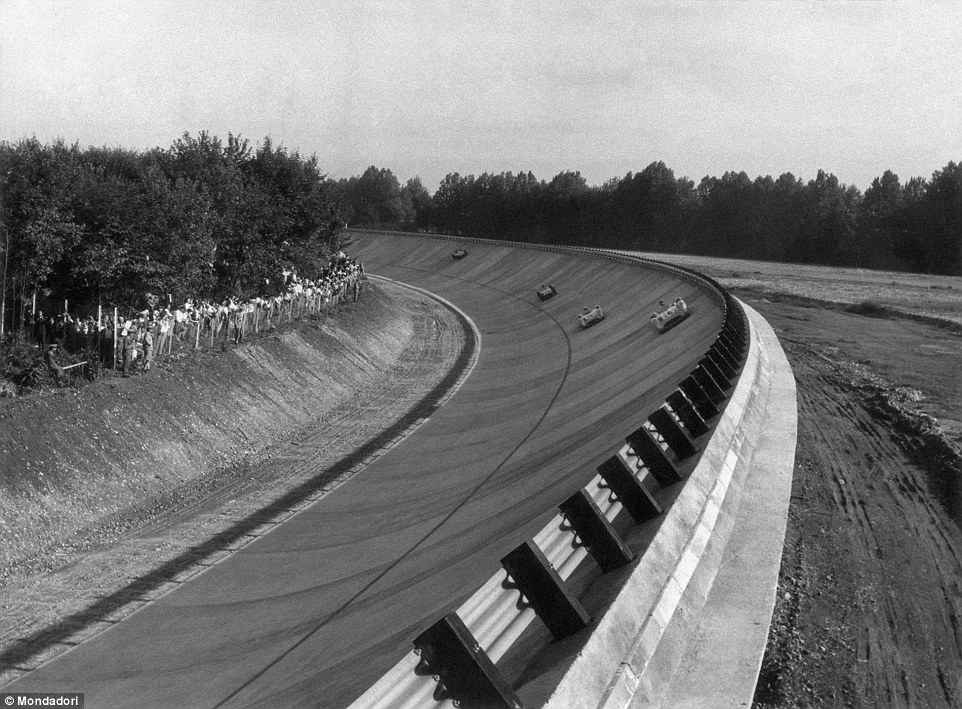
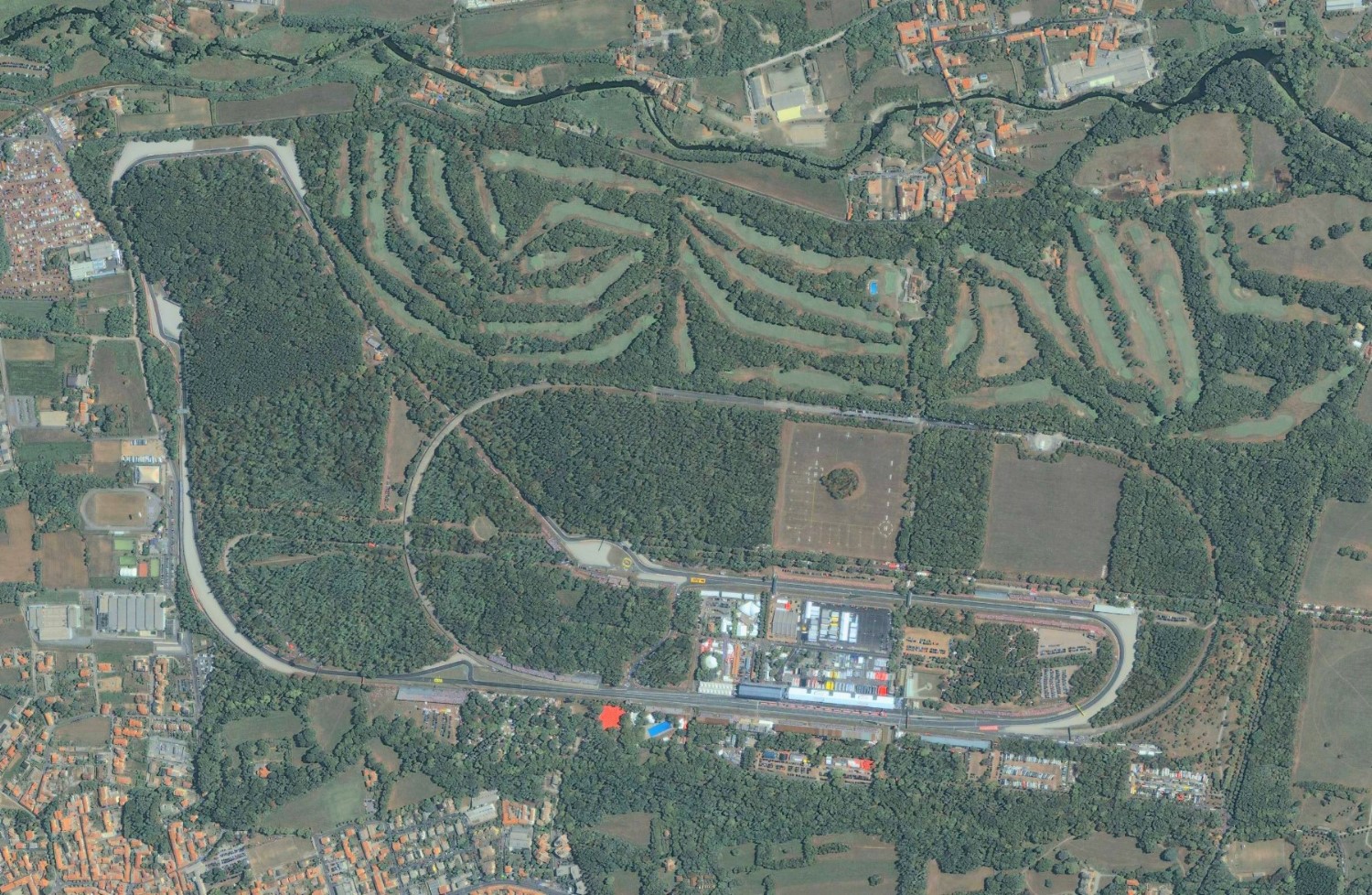
There is something unique about Monza. It’s not the octane-laden atmosphere, no matter how fantastic, or the sight of tens of thousands of fans creating a flowing sea of color (admittedly, mostly red) on grandstands and grass alike; it’s not the track, no matter how many thrilling, joyous or tragic pages of the history of our sport have been written on its kilometers of tarmac; it’s not the slightly melancholic feeling of the final European race of the season, of leaving behind your hospitality – home away from home – until the cold mornings of pre-season testing in Barcelona.
No, there’s something unique about Monza, and that’s the nature of this circuit itself. It’s what this track embodies – in the history of motorsport, in the collective imagination of everyone connected with racing, in the very center of the Italian psyche. Monza is racing: it is racing at its purest, it is human and machine versus the laws of physics. It is banking so steep it’s dizzying; corners that have no numbers but names; crumbling tarmac on forgotten parts of the track where you can hear echoes of Farina, Fangio, Rindt, Clark, Senna and Schumacher, heroes through the eras.
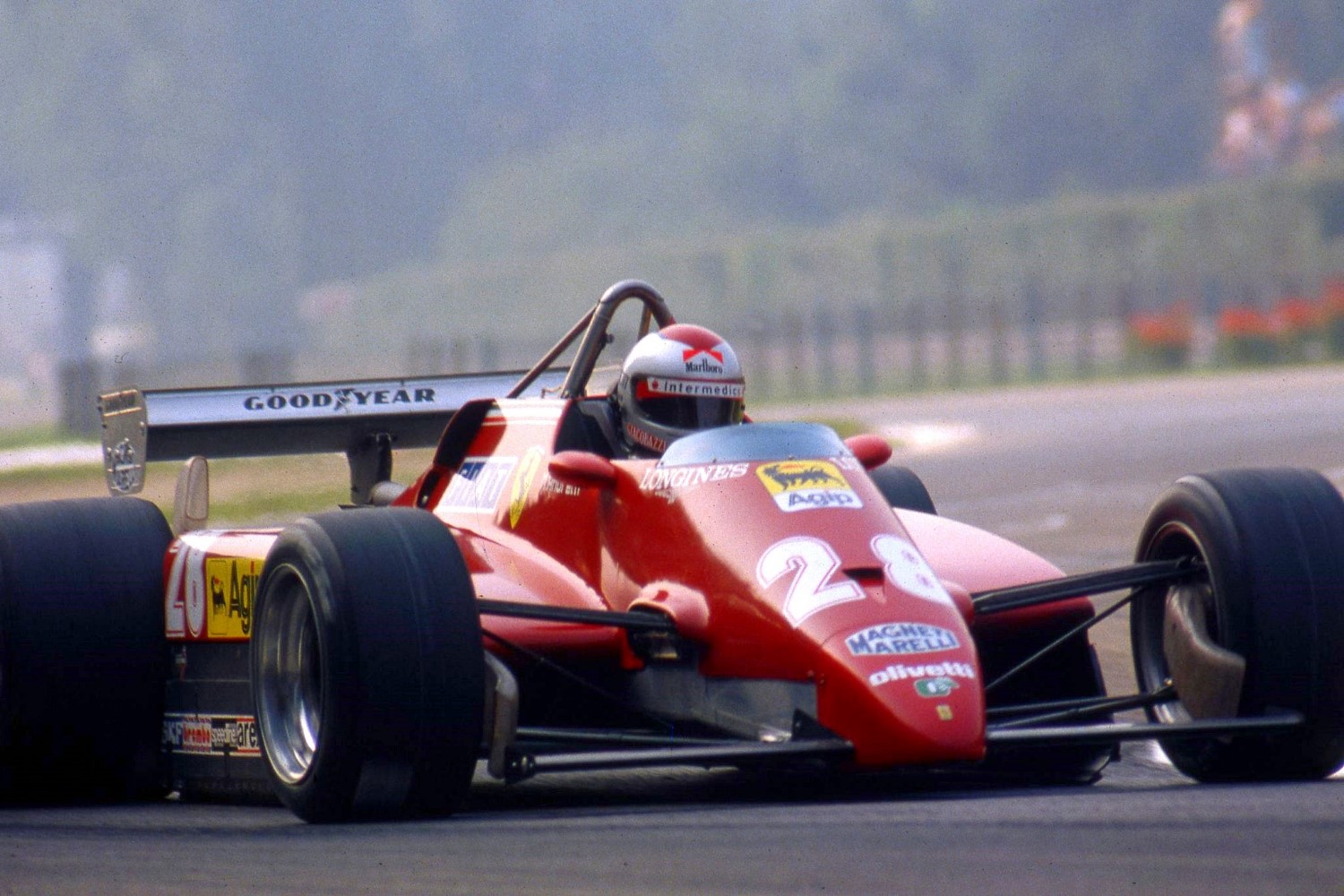
Monza has been synonymous with racing since September 1922 – 100 years ago. This wedding of two concepts, now indissoluble, has been threatened, left for dead, considered a relic of the past – only to return with more passion, more determination, more of a central role in our imagination. It’s been here for 100 years, and we hope it’ll be here for 100 more.
Weather Forecast
Friday, August 30: FP1 and FP2
The weekend kicks off with a sunny day, with temperatures reaching a high of 32 degrees Celsius and a low of 23 degrees.
Despite the heat, there’s a slight chance of showers during both practice sessions, with a 10 percent probability forecast for each.
Humidity is expected to be relatively high, reaching up to 58 percent.
Saturday, August 31: FP3 and Qualifying
The warm conditions persist on Saturday, with high temperatures remaining around 32 degrees and lows dropping to 22 degrees.
The final practice session could be disrupted by rain, with a 40 percent chance of showers. This precipitation could also carry over into the qualifying session later in the afternoon.
Sunday, September 1: Race
Race day could see the highest chance of rain, with a 50 percent probability forecast for the morning and early afternoon.
However, conditions could improve as the race progresses, with a potential for drier weather later in the day.
Humidity levels will be around 48 percent, and temperatures will reach a high of 30 degrees.
However, it’s important to note that these forecasts are subject to change. We will be updating you daily with the latest forecast, so be sure to check back in as the week progresses.
Record Crowd expected
Monza is preparing for a record crowd at this year’s Italian GP.
Formula 1’s popularity is surging this year, which looks set to translate into a huge crowd at Monza as the Tifosi support Charles Leclerc’s title push.
“We are still expanding the temporary stands so as not to leave anyone out,” said Angelo Sticchi Damiani, president of the Italian automobile club Aci.
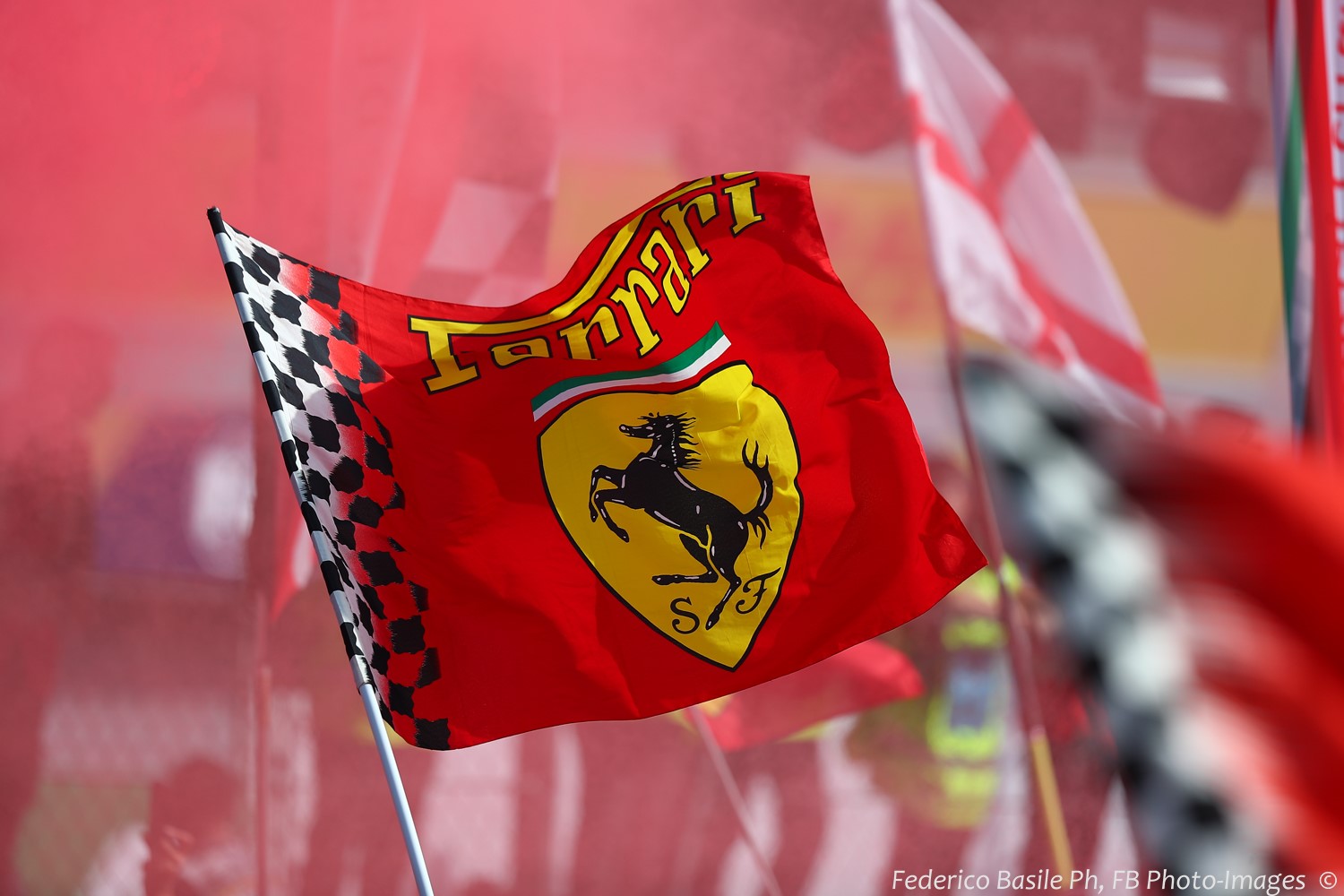
“The numbers for the Monza GP are already exceptional,” Sticchi Damiani told Rai radio.
“We are heading towards 320,000 spectators over the weekend – numbers we’ve never seen.”
Last Year’s Race
World Driving Champion Max Verstappen out dueled both Ferraris early, passed Carlos Sainz Jr. on lap 15 and then eased to his 10th straight F1 win in the Italian GP.
In what was an exciting 2023 Italian GP with close battles and passes all race long, Verstappen’s record 10th consecutive win breaks a tie he enjoyed with Sebastian Vettel with 9 consecutive wins. It was Verstappen’s 12th win of the year in 14 races, and his 47th career F1 win.
!["I mean, I never would have believed [10] was possible, but we had to work for it today, so that was fun. It was so hard to get close and get a move into Turn 1, I had to force [Sainz] into a mistake. I tried to stay patient, it's a long race and I just had to pick my moment."](https://www.autoracing1.com/wp-content/uploads/2023/f1/monza/verstappen-10-straight.jpg)
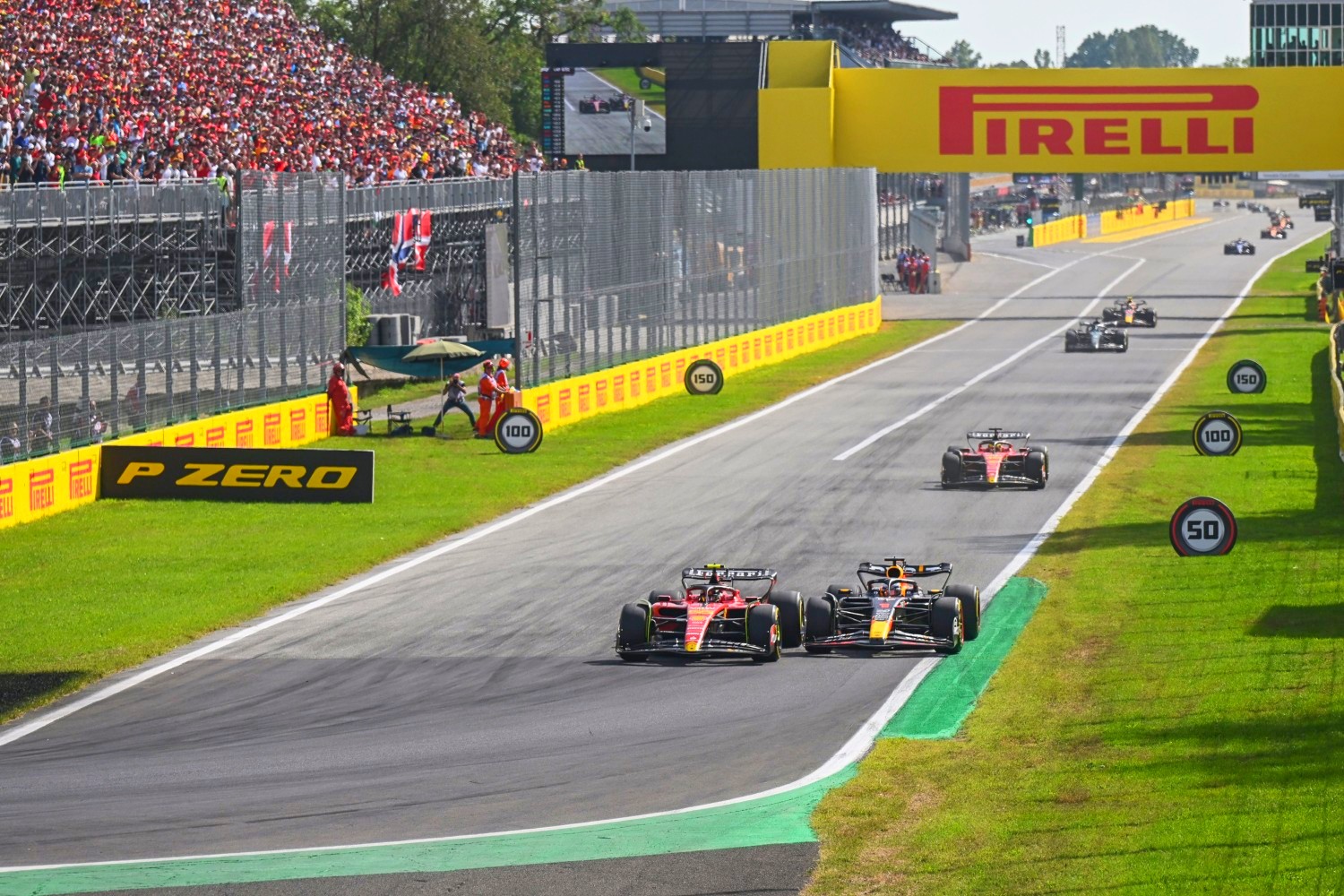
Sergio Perez battled hard with the two Ferraris and picked them off one at a time to make it a Red Bull Honda 1-2 finish.
“To get through Charles and then Carlos – I had to use all of my tires,” said Perez.
“I really thought at times, especially at the beginning… in the end we managed to get both of them. I feel a lot more comfortable in the car so I think we’ll see my best form in the next races.”
Polesitter Carlos Sainz Jr. finished third for the final podium position after a hard battle with his teammate Charles Leclerc who finished 4th.
“Very tough, very tough,” said Sainz.
“It can’t get any tougher than it was today. To keep up with the Red Bulls, I paid the price with the rear tires, but I did everything I could to defend. Hard racing, it’s always a pleasure to race Charles when we had a chance. We had fun out there!”
George Russell came home a lonely fifth despite having a 5-second time penalty for passing off track, likewise Lewis Hamilton’s 5-second time penalty for crashing into Oscar Piastri didn’t cost him a place as he finished sixth.
Alex Albon gave Williams some more points in seventh, defending from the other McLaren of Lando Norris in a race to the finish line, as the Aston Martin of Fernando Alonso and Alfa Romeo of Valtteri Bottas completed the top 10.
Liam Lawson finished on the brink of the points in his second appearance in place of Daniel Ricciardo at AlphaTauri, with Piastri 12th after the incident involving Hamilton and a five-second penalty for leaving the track and gaining an advantage.
Williams rookie Logan Sargeant was left to rue his own coming together with Bottas – and a five-second time penalty for causing that collision – en route to 13th, followed by the other Alfa Romeo of Zhou Guanyu and Pierre Gasly’s Alpine.
It was a quiet afternoon for Aston Martin’s Lance Stroll after his back-of-the grid start, the Canadian taking 16th at the checkered flag from the Haas machines of Nico Hulkenberg and Kevin Magnussen, who had another challenging race day.
Two drivers failed to make it to the finish, with Ocon retiring late on in the second of the Alpines and Yuki Tsunoda watching the action from the sidelines after a reported engine failure on the formation lap put his AlphaTauri out before the race had even started.
Circuit Insight
Overtaking: Although the Autodromo Nazionale Monza has many long straights, overtaking difficulty hovers around the season average. The best opportunities are into the opening chicane, although Turns Three and Four, and down the shorter DRS zone into Turn Eight.
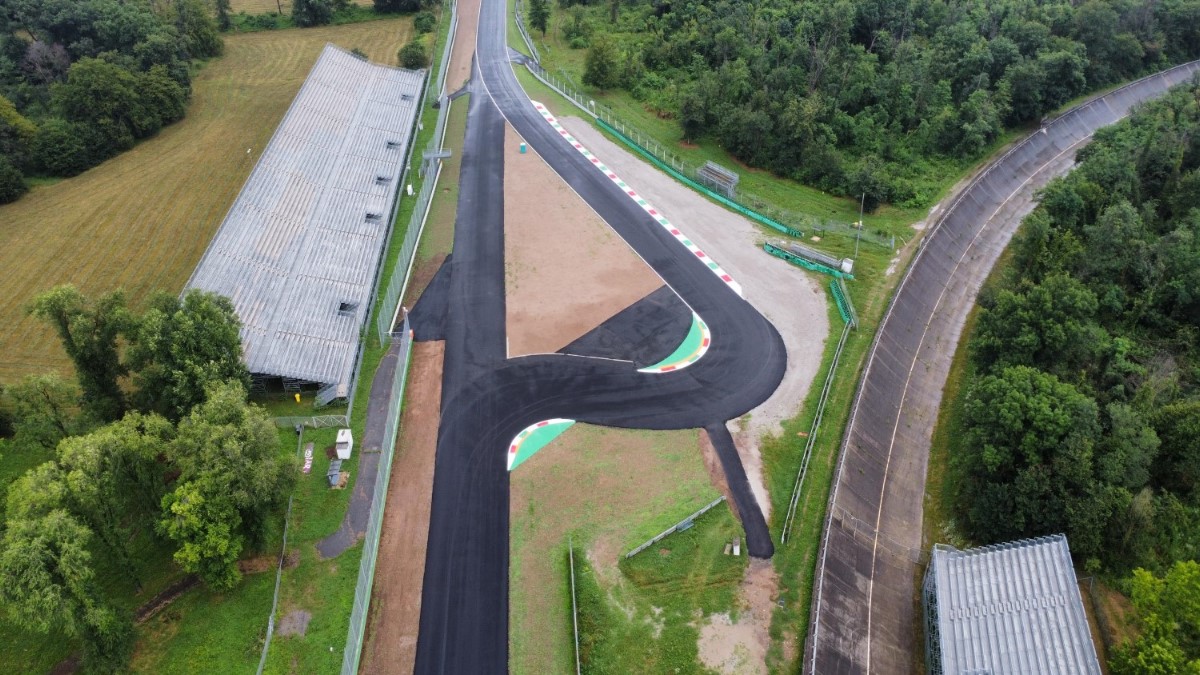
Race disruptions: Stoppages are likely to occur and provide a prime opportunity to pit: In the last five dry Grands Prix at Monza, there has been an average of one Safety Car and one Virtual Safety Car per race. Last year, both were deployed during the Grand Prix.
Strategy: The tires are a step softer than last year – C3, C4 and C5 – and the Alternative Tire Allocation is in place meaning that teams get three sets of Hards, four sets of Mediums, four sets of Softs, and two fewer sets of tires overall per car for the whole weekend. Hards must be used in Q1, Mediums in Q2 and Softs in Q3.

A lap opens with a long run down to the first corners – a very tight right-left chicane that is one of the slowest sections on the whole calendar.
With low-downforce packages on the cars, it can be easy to misjudge the braking point. The exit is also key, with a long flat-out blast through the Curve Grande following.

The Variante Ascari is the third, and perhaps the most challenging, of the track’s chicanes. Deceptively quick, carrying too much speed or hitting the curbs can really upset the stability of the car, sending it into a spin.
Again, the exit is crucial here, with another long straight following this corner.
Parabolica – now renamed Curva Alboreto after the late Italian racer – concludes the lap. It is a long right-hander that opens up on exit.

The apex can be difficult to perfect, particularly while following another car, and it is also easy to exceed track limits. It’s a key corner.
Monza is nicknamed ‘Temple of Speed’ and for good reason, as 76% of the lap time and 83% of the lap distance are taken at full throttle – the highest of any F1
Due to the long straights and large portion of lap spent in eighth gear, Monza is one of the lowest tracks for gear changes per lap, with only
The Italian GP is the lowest downforce level of the year and requires a special rear wing, just for this There is still enough downforce to – in theory – drive a car upside down, though.
Monza has the highest average corner speed of any F1 track, with the fast Curva Grande (Turn 3) and Parabolica (Turn 11) counterbalancing the various slow chicanes that split up the long
The tow is massively powerful in Monza and is particularly important in qualifying, leading to battles on track to find a tow – you don’t want to be at the front of the pack, punching a hole in the air for everyone It can bring as much as 0.25 seconds of lap time per lap.
Fact File: Italian Grand Prix
- Monza is nicknamed the ‘Temple of Speed’ and for good reason. Recorded top speeds through the speed traps during the Grand Prix typically top 350 km/h.
- Due to the long straights and large portion of lap spent in eighth gear, the Monza lap is one of the lowest for gear changes on the calendar, with just 38.
- The high-speed nature of Monza means the Italian Grand Prix is often one of the shortest races of the year. If run uninterrupted, it usually takes around one hour and 15 minutes from lights out to the chequered flag.
- The circuit contains just 11 corners, four to the left and seven to the right. That is the second fewest of the year, behind only Austria which has 10.
- Extensive work has taken place at Monza ahead of this year’s race, with significant upgrades to circuit infrastructure.
- The entire circuit has also been resurfaced and new kerbs installed which may give drivers a chance to carry a little more speed into certain corners.
- The 476m run from pole position to the first braking point at Monza is the fourth longest on the F1 calendar. Only Mexico, Great Britain, and Spain are longer.
- Monza has the highest percentage time (76%) and distance (84%) per lap spent at full throttle of any circuit on the F1 2024 calendar.
- Mechanical grip is crucial due to the amount of these acceleration zones out of low-speed corners. The track has one of the highest traction demands of the season.
- The high-speed nature means the Italian Grand Prix is often one of the shortest races of the year. If run uninterrupted, it usually takes around one hour and 15 minutes from lights out to the checkered flag.
- Several corners, such as Ascari, are dominated by how well your car can ride the curbs on entry. If the car is stable, drivers can attack much more easily but a lot of time can be lost if they are unable to do so.
- On exit, the curbs tend to offer poor traction and a bumpy ride, so drivers sometimes avoid the exit curbs altogether to get the best run out of the turn.
- FP1 in Italy will see junior driver Kimi Antonelli take part in his first F1 practice session. The Italian will drive George Russell’s car, for the Mercedes team’s first of two mandatory FP1 sessions where a rookie driver must be used.
How do you prepare a car for the unique demands of Monza?
Monza is a special circuit in that it requires a low-drag set-up. This is most evident on the rear wings of the cars where a cursory glance reveals shorter main planes and therefore smaller aerodynamic surfaces, which reduce the amount of drag – but also the amount of downforce – produced by the wings.
There is a trade-off between straight-line speed and cornering speed – a dilemma which presents itself at every circuit – and at Monza, straight-line speed is prioritized, with drivers spending more than 70 percent of the lap at full throttle. If rain is expected, set-up might be tweaked to add a bit more downforce and drag, and give the drivers an advantage in slippery conditions.
Given the amount of time spent at full throttle, it’s also imperative to ensure that the engine and related components are in top condition in a bid to maximize power and reliability.
Unlocking the lap
The long run to the Rettifilo chicane gives drivers plenty of time to nail their braking point at the hardest braking zone on the circuit – made even more tricky with a low-downforce set-up. A perfect exit out of Turn Two is key to gaining an advantage through Curva Grande and onto the short straight that follows.
Then comes the high-speed Della Roggia Chicane, where it’s tempting to take plenty of kerb. However, the run-off area and its gravel comes quickly and can trigger a spin, so it’s important not to use too much of the exit curb. The high-speed Lesmo corners follow: Turn Six is slightly cambered which allows drivers to carry more speed into the corner and the track is even more cambered into Turn Seven – but the run-off area is once again waiting to punish any drivers who take too much exit curb.
The short DRS zone follows the Lesmos into Turns Eight, Nine and 10 – the Ascari Chicane. This requires precision and a hefty use of the curbs on corner entry to position the car to take plenty of the inside curb and outside curb on exit of the chicane. Finally, drivers blaze into Curva Alboreto, a constant radius corner, where it’s important to get on the throttle early for a rapid run down the main straight.
Pirelli Tires
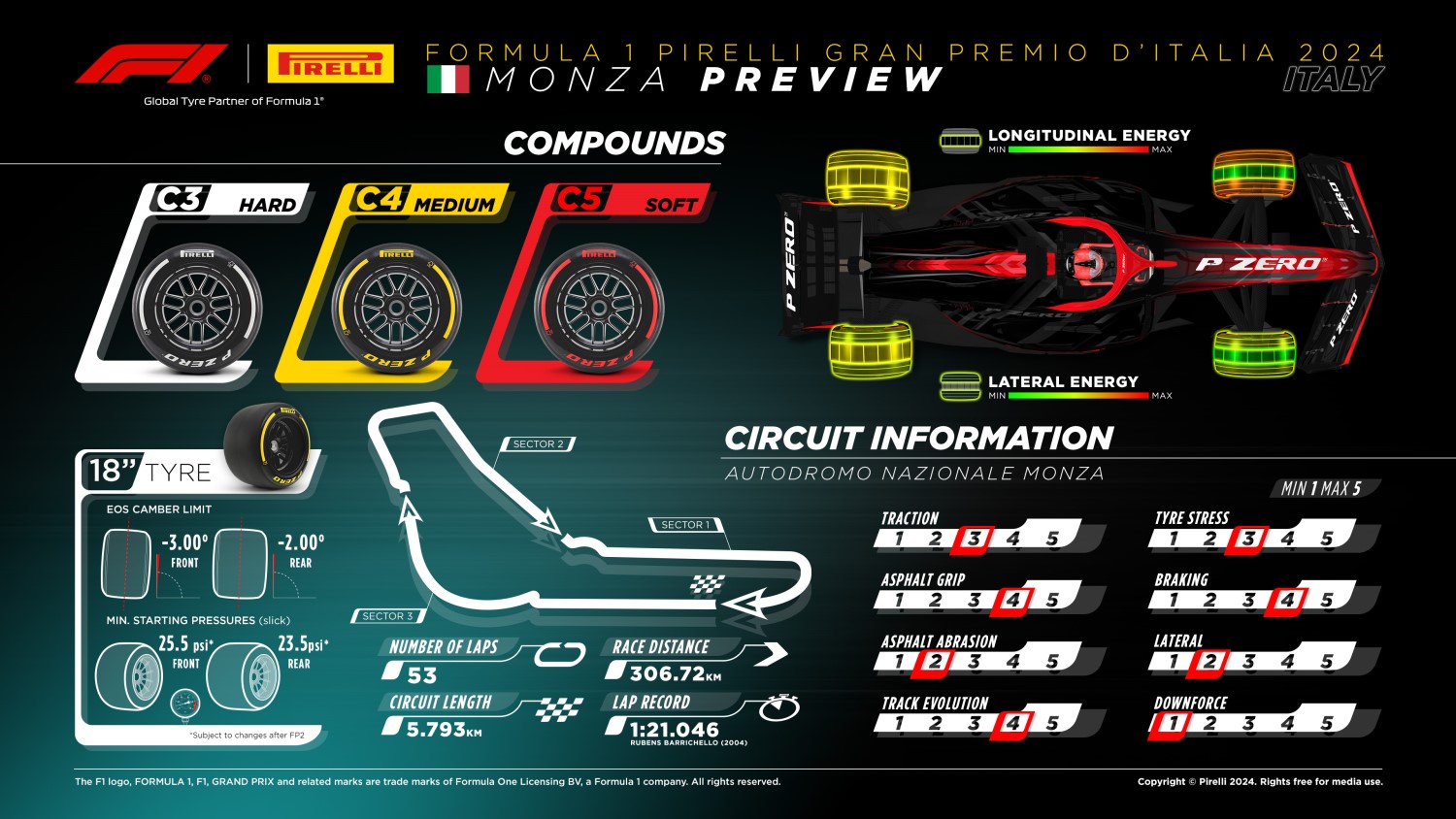
For this year’s event, the three dry compounds selected are the same as in 2023: C3 as Hard, C4 as Medium and C5 as Soft.
This is a track where the time needed for a pit stop is one of the longest of the year so, on paper, a one-stop strategy is quickest. In free practice, it will be important to evaluate what effect the new surface might have on tire behavior over a long run, both in terms of performance and of degradation. Last year, the race was very linear, with the two hardest compounds being the clear choice. 17 of the 20 drivers chose to start on the C4, while only three – Hamilton, Bottas and Magnussen – preferred the C3. 14 drivers pitted just the once, six pitted twice, although in Piastri’s case that was down to the need to change the front wing after a collision with Hamilton. The remaining five – Gasly, Zhou, Lawson, Hulkenberg e Magnussen – adopted this strategy because the drop in performance from the tires was already too high in the first stint.
